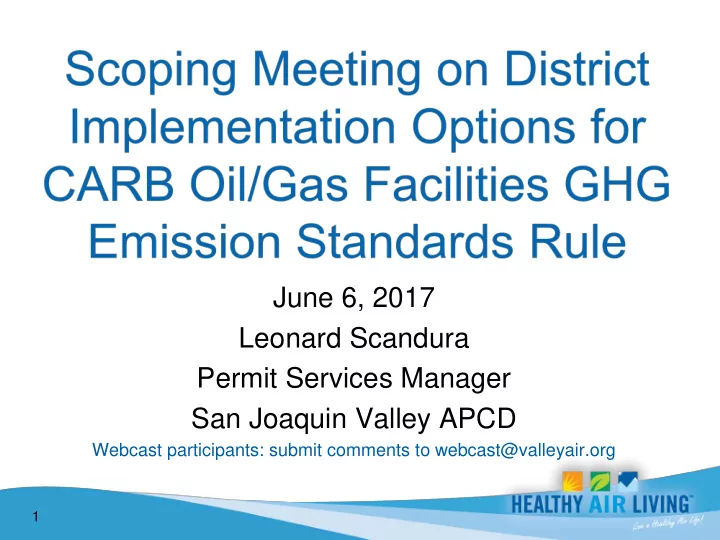

June 6, 2017 Leonard Scandura Permit Services Manager San Joaquin Valley APCD Webcast participants: submit comments to webcast@valleyair.org 1
• Overview of existing regulations for oil/gas fugitive VOC and methane emissions • Overview of new CARB rule for oil/gas fugitive methane emissions • District implementation options for CARB rule • Next steps • Questions/comments 2
• Target VOC (not methane) emissions • In-place for over 25 years • Rules 4623 – Storage of Organic Liquids • Rule 4401 – Steam Enhanced Crude Oil Production Wells • Rule 4409 – Components at Light Crude Oil Production (> 30 o API), Gas Production, and Gas plants • Others - Rule 4402 (sumps), 4407 (In-Situ Combustion Wells), 4408 (Glycol Dehydration Systems) 3
• NSPS Subpart OOOO – Oil/gas production, transmission, distribution – New/modified equipment 8/23/11 – 9/18/15 – VOC emissions only • NSPS Subpart OOOOa – Oil/gas production, transmission, distribution – New/modified equipment after 9/18/15 – VOC and methane emissions – Certain provisions stayed 6/5/17 - 8/31/17 • fugitive emission requirements stayed 4
• AB-32 Global Warming Solutions Act of 2006 • AB-32 Implemented by CARB • Multi-faceted approach by CARB to reduce GHG emissions – Cap and Trade regulation – Source specific regulations, including oil/gas industry 5
• Industry/California Districts consulted by CARB • CARB public workshops • 80% of oil/gas production in CA is in the Valley • Adopted by CARB March 23, 2017 6
• Applies to equipment/components used in: – Crude oil/gas production – Crude, condensate, and produced water separation/storage – Natural gas underground storage – Natural gas gathering/boosting stations – Natural gas processing plants – Natural gas transmission compressor stations 7
Emission/control standards: – Separator/tank systems – flash testing, possible vapor control, exemption for small producers – Well stimulation circulation tanks – best management practices, emission testing/technology assessment (grouped okay) – Reciprocating/centrifugal compressors – leak requirements – Natural gas pneumatic devices/pumps – bleed rate requirements 8
Emission/control standards: – Open well vents - measure gas flow – Natural gas underground storage - monitoring plan LDAR for components at regulated facilities – Exemptions for - components subject to District LDAR, heavy oil (< 20 o API), others – Quarterly LDAR using EPA method 21 9
Critical components – Longer leak repair time allowed – Must be approved by CARB Standards for required vapor collection/control systems – If available, use sales gas line, fuel gas line, existing gas disposal well – Alternatively, use vapor control device w/ 95% control and NOx < 15 ppmv @ 3% O2. Applies to new and existing devices used to comply 10
Detailed record keeping (5 years retention) and reporting (annually beginning 7/1/18) requirements CARB Final staff report expected in late June will provide guidance on various rule interpretation/applicability questions 11
• Implementation by CARB or the District • District implementation benefits – District staff familiar with facilities – Efficient use of government funds – Supported by industry – Supported by CARB – Need MOA between CARB and District in order to proceed with implementation 12
• Minimum information to be provided by owners specified in the rule – Owner/operator name/contact info – Address of each facility (contiguous/adjacent) with equipment subject to rule – For each facility - inventory of equipment subject to rule; annual crude oil, produced water, natural gas throughput 13
• Minimum requirements for District program specified in the rule – Permit #s and conditions that ensure compliance with rule – or reason why not included – Declaration from operator that information is true and correct – Annual updates by Jan 1 every year 14
• Need to include currently un-permitted facilities – natural gas compressor stations, others • District must recover costs for implementation – All efficiency streamlining efforts to be utilized – Initial costs – permitting, registration, etc. – Ongoing costs - inspections, annual report review, others • CARB funds available to offset District’s implementation costs – Amount available TBD 15
Option #1 Incorporate requirements into each affected PTO, require PEERs to enforce requirements for exempt equipment • Revise Rule 2250 PEER to allow PEERs for exempt equipment to enforce CARB oil/gas rule • Possibly revise Rules 3020 (PTO fees) and 3155 (PEER fees) to recover costs for implementing CARB oil/gas rule – only if CARB funds insufficient 16
Option #2 Incorporate requirement into each affected PTO, enforce requirements for exempt equipment through compliance plan • Possibly revise Rule 3020 to add PTO surcharge fee recover ongoing inspection costs 17
Option #3 Incorporate requirements into facility-wide requirements for permitted equipment, require a facility-wide PEER for all exempt equipment • Revise Rule 2250 PEER to allow PEERs for exempt equipment to enforce CARB oil/gas rule • Possibly revise Rules 3020 (PTO fees) and 3155 (PEER fees) to recover costs for implementing CARB oil/gas rule – only if CARB funds insufficient 18
Other Options • Incorporate requirements into facility-wide requirements for all equipment – permitted and exempt equipment – Not feasible as it would require exempt equipment be permitted • Enforce via submittal/approval of a compliance plan – May not be approvable by CARB, as requirements would not be incorporated into District PTO/PEERs 19
• Evaluate comments received • Select best option • Public workshop for Rule amendments – Reg II – Permitting/PEERs – Reg III – fees to recover costs – only if CARB funds insufficient • Ongoing – Work with stakeholders/CARB to develop a FAQ document 20
• If you have comments, questions, suggestions: leonard.scandura@valleyair.org mike.oldershaw@valleyair.org 661-392-5500 • Comments due by June 22, 2017 21
Recommend
More recommend